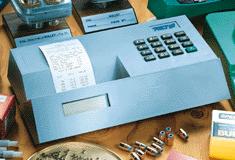 My Pact chronograph met an untimely, well maybe timely demise a month or so ago. Ruthlessly shot several timed though it’s little inverted sensors, it struggled to continue giving readings, but eventually passed on when its battery gave out. All attempts to revive it proved to be futile. R.I.P.
My Pact chronograph met an untimely, well maybe timely demise a month or so ago. Ruthlessly shot several timed though it’s little inverted sensors, it struggled to continue giving readings, but eventually passed on when its battery gave out. All attempts to revive it proved to be futile. R.I.P.
My Pact looked a lot like the catalog shot at the left, only the printer paper never actually came out of the top, it just sort of stood still while the little built in “printer that couldn’t” ground the battery into the dirt. It’s flimsy plastic case lined up pretty well with the buttons that controlled the onboard computational functions, buttons that served little purpose beyond offering something to play with when the unit was first removed from the box. It did read velocity accurately, but only if shading the little display from ambient light with one hand, while jotting the readings down in a little notebook with the other. I don’t believe the earlier mentioned shooting was a homicide, but we can’t really be sure, can we ?
Handloads are so much faster without them….
When I was a much younger, it was common place to see a lot of backyard garage built high performance cars on the road, with each proud owner claiming his vehicle was able to cover a quarter mile in less than 12 seconds. Curiously enough, when a new drag strip was built, all of these cars mysteriously slowed to 14 seconds (and then some) under the scrutiny of the track’s set of light beams, photo cells and timing circuits. The results sent a lot of cars back to garage for further development. The relationship of handloading to chronographs isn’t a whole lot different.
 Objective velocity measurement of handloading results can, and should, lead to further handload development. In addition, knowing how fast the bullet leaves the barrel of a specific firearm will allow us to determine bullet trajectory along line of sight, as well as how fast the bullet will be traveling, and how hard it will hit at any selected distance. The ballistic chronograph isn’t much more than two sensors spaced a known distance of apart, and a timing circuit. When the bullet crosses the first sensor, the clock starts, when it crosses the second sensor, the clock stops. Then some software, written by the guy who didn’t fall asleep in algebra class on the day they were working on time distance problems, interprets the results into feet per second. Throw in a little calculus with some bullet specific streamlining values, and you’ve got a ton of external ballistic information.
Objective velocity measurement of handloading results can, and should, lead to further handload development. In addition, knowing how fast the bullet leaves the barrel of a specific firearm will allow us to determine bullet trajectory along line of sight, as well as how fast the bullet will be traveling, and how hard it will hit at any selected distance. The ballistic chronograph isn’t much more than two sensors spaced a known distance of apart, and a timing circuit. When the bullet crosses the first sensor, the clock starts, when it crosses the second sensor, the clock stops. Then some software, written by the guy who didn’t fall asleep in algebra class on the day they were working on time distance problems, interprets the results into feet per second. Throw in a little calculus with some bullet specific streamlining values, and you’ve got a ton of external ballistic information.
Let’s recap – The chronograph can serve several important purposes. It can prove your reloading buddy really isn’t getting his claimed 4,500 fps out of his 168 grain .308 loads. It can measure the velocity of your favorite handloads and tell you if they are being loaded with an acceptable degree of round to round consistency. The data collected from the chronograph can help you in the field; plotting trajectory over any distance, and advising if your bullet will have sufficient steam to knock over, whatever you’re trying to knock over, at the distances you intend to knock it over. The chronograph can be a very useful and practical tool.
Chronograph performance, the mind wanders…
There are a few factors that effect the accuracy of any chronograph. The distance separating the sensors or screens, typically 12″ – 48″ for most portable setups, is significant. Increasing sensor spacing can improve a chronograph’s tolerance to error in sensor placement, but perhaps of greater importance, extending this distance can diminish inaccuracies caused by electronic component operating tolerances, and relatively slow circuit sampling rates. Longer spacing permits more sampling, and more sampling typically results in a more accurate statistical results.
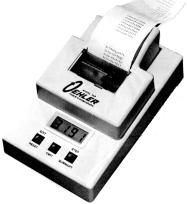 Oehler, probably the chronograph manufacturer with the greatest technical experience, does a good job of placing the anticipated screen spacing and circuit errors into a practical framework athttps://www.oehler-research.com/specs.html. Pact makes no reference to percentage of accuracy or repeatability of readings regarding their products, Shooting Chrony claims better than 99.5% accuracy between 30 fps and 7,000 fps. Based on this published information, Shooting Chrony’s error would be 20 fps at velocities of 4,000 fps, Oehler’s would be 21 fps with 12″ of screen separation. There is a certain reassurance in the closeness of these number that makes them credible, and cause me to believe there is a product performance specification common to chronograph manufacturers.
Oehler, probably the chronograph manufacturer with the greatest technical experience, does a good job of placing the anticipated screen spacing and circuit errors into a practical framework athttps://www.oehler-research.com/specs.html. Pact makes no reference to percentage of accuracy or repeatability of readings regarding their products, Shooting Chrony claims better than 99.5% accuracy between 30 fps and 7,000 fps. Based on this published information, Shooting Chrony’s error would be 20 fps at velocities of 4,000 fps, Oehler’s would be 21 fps with 12″ of screen separation. There is a certain reassurance in the closeness of these number that makes them credible, and cause me to believe there is a product performance specification common to chronograph manufacturers.
Oehler enhances the performance of its Model 35 by adding a third sensor halfway between the typical start/stop timers. Labeled a Proof Channel, the third sensor’s job is to validate the readings by taking a third sample and compare it to the readings of the other two sensors. I don’t know… It looks as though the first sensor starts two timing sequences, the proof channel sensor stops one timer and the third sensor stops the other. The chronograph then compares the two results to see if they are within 4% of one another. If they are not, an alarm sounds. If the problem were with the first sensor, it would seem this would effect both of the remaining sensors readings. Even if all sensors work correctly, they are still collectively plugged into the same circuits, and running through the same software, so I don’t think this set up assures accurate readings, but it can serve to advise of obvious reading errors within the normal level of accuracy of the equipment.
All chronographs contain software that detects the bullet flying over the sensors, even against a backdrop that does it’s best to mask the bullet’s presence. The effect of ambient light extremes, reflective bullet surfaces, particle clouds of muzzle blast, and shock waves all do their best to obscure the motion of the bullet moving over the sensors, and triggering erroneous readings. When the software misses, it’s pretty easy to detect; a huge flyer in readings or a display staring at you with a blank look on its face. At least a couple of chronograph producing companies offer infrared diode screens that can typically detect smaller projectiles at very slow speeds and operate with higher sensitivity across all ranges. Eliminating the visible light spectrum should be beneficial, but I’m not sure what the increased sensitivity is to other environmental factors, and most require 120v for operation.
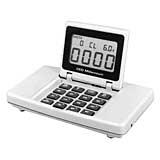 Competitive Edge Dynamics offers their Millennium model chronograph with a claim of .2% accuracy, and a suggestion of even more with their infrared screens, but I am not familiar with the product and didn’t care for the large sky screen mounting frame and talking console. I also didn’t care for the way they structured their product and options to hide, when compared to the competitor’s package contents, a relatively high priced piece of equipment. The price worked out to $258 for chronograph and software function included in products from other manufacturers, another $90 for infrared screens and there is no printer. A similar Model 1 from Pact is about $129, A Master Alpha Chrony for about $114, and an Oehler base Model 35 for $195. Oehler also offers an infrared screen option.
Competitive Edge Dynamics offers their Millennium model chronograph with a claim of .2% accuracy, and a suggestion of even more with their infrared screens, but I am not familiar with the product and didn’t care for the large sky screen mounting frame and talking console. I also didn’t care for the way they structured their product and options to hide, when compared to the competitor’s package contents, a relatively high priced piece of equipment. The price worked out to $258 for chronograph and software function included in products from other manufacturers, another $90 for infrared screens and there is no printer. A similar Model 1 from Pact is about $129, A Master Alpha Chrony for about $114, and an Oehler base Model 35 for $195. Oehler also offers an infrared screen option.
Enter the Shooting, Master, Gamma, Ballistic Printing…..Chrony
I passed on the Pact for reasons stated in my opening comments, and I passed on the Oehler 35 because I felt this model offered little for the relatively high price and, more so, they are a tad huge to haul around. If I were very serious and committed to the equipment, I might have considered a Model 43 set up, but this is way beyond my current requirements. I figured it was time to take a look at a Shooting Chrony.
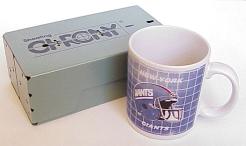 Why is the Chrony sitting next to my 1986 NY Giants Super Bowl cut ? Well, since it’s a normal size coffee cup, I thought it would offer a perspective on how very small this chronograph is. In addition, since the cup’s fading, I thought this would be a way to preserve the memory of a rare occasion, the Giants in the Super Bowl.
Why is the Chrony sitting next to my 1986 NY Giants Super Bowl cut ? Well, since it’s a normal size coffee cup, I thought it would offer a perspective on how very small this chronograph is. In addition, since the cup’s fading, I thought this would be a way to preserve the memory of a rare occasion, the Giants in the Super Bowl.
The fold up size of the Chrony is not a small issue. Unless you can set up your chronograph some place where you can leave it for awhile, it’s a chore to haul larger units around. The Chrony only requires the addition of a tripod, everything else folds up in the case, with the exception of a printer and sky screens. Chrony does sell a very small carry case that fits all of the gunk inside, but mine came with a small cardboard box that fits just swell.
One of the reasons I didn’t purchase a Chrony sooner, was because I couldn’t figure out all of the model designations and what features they offered. I believe I’ve finally figured it out. If you’re brave and want to have the electronics integrated into the little metal box, four inches below the line of fire as though yelling “Shoot me! Shoot me!” – the Shooting Chrony is the model from you. One errant shot, and not only do you take out both sensors, as you would on virtually all chronographs, but you’ll score the unit’s electronics and display as well. If you have some reason, any reason, to believe you may one day misjudge the elevation of the gun being fired, or the height of the chronograph, the Master Chrony is the way to go. But the selection fun doesn’t stop there…
F1 Master Chrony $99
-
Gives numbered shot velocities;
-
Velocity stays on display until you shoot again;
-
Stereo Jack for optional Remote Control or Printer;
-
Upgrades to any model.
-
Uses one 9 volt alkaline battery with 48 hours of continuous use.
Alpha Master Chrony – $119.95 All the features of the F-1 plus –
-
One string, from 2 to 32 shot memory
-
Measures High, Low and Avg Vel, Extreme Spread and Standard Deviations.
-
Retrieval of individual shot velocity measurements
-
Delete individual shots from memory (with automatic adjustment of Statistics)
-
Timer Option
Beta Master Chrony – $129.95 All the features of the Alpha plus –
-
60-shot memory (6 strings from 2 to 10 shots), with statistics for each string
-
Can be switched off and later reviewed or downloaded to a computer
-
Interrupts shooting and moves from string to string without memory loss
-
Forget Button to clear individual string-memory instantly
-
Change string size
-
Delete individual shots, or all data from memory
-
Timer Option
-
Upgrade to 1000 shot memory or Gamma/Gamma Master Chrony
Gamma Master Chrony – $199.95 All the features of the Beta plus –
-
Ballistic Chrony Printer. Will also print Timer-Data
-
PC Bullet Ballistic Program for Windows
-
500 shot memory (50 numbered strings of 2 to 10 shots each)
-
Memory for 500 individual Timer Read-Outs
-
Timer Button
-
The Gamma (at all times) measures and stores not only shot velocities but also time-elapsed between shots, including total time. When in Timer-Mode the Chrony will also measure velocities at a rate of up to 1800 rounds/minute as well as the time elapsed between shots.
There is a parallel set of Shooting Chrony Models that run a few bucks less, but make little sense about the time the models incorporate remote control and display. You can get these units from Chrony as well as for a few dollars less from Midway USA and Brownells. In fact, Brownells sells all of the manufacturer’s products noted in this article.
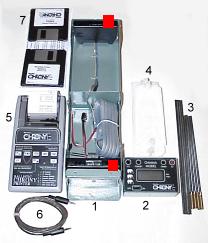 This is what the entire Master Gamma set up looks like when you take it out of the box and unfold the case. 1 is the fold open box that contains the sensors or photocells. In use, it is screwed on to a tripod and place 10 feet or so down range from the guns muzzle. 2 is the display and remote that operated the chronograph and provides readings. 3 us the rod sets that frame the shooting area and support 4, the diffuser panels that create a uniform light over the photocells. 5 is the very nice full featured printer that plugs into 2 with cable 6. The red squares mark the positions of the front and rear photocells.
This is what the entire Master Gamma set up looks like when you take it out of the box and unfold the case. 1 is the fold open box that contains the sensors or photocells. In use, it is screwed on to a tripod and place 10 feet or so down range from the guns muzzle. 2 is the display and remote that operated the chronograph and provides readings. 3 us the rod sets that frame the shooting area and support 4, the diffuser panels that create a uniform light over the photocells. 5 is the very nice full featured printer that plugs into 2 with cable 6. The red squares mark the positions of the front and rear photocells.
7 is the software program that runs on a Windows based PC and permits optionally downloading data from the Chrony to your PC. I labeled this optional because you can get all of your information off the display or from the printer. So this program actually provides extended functions, and is not require in the routine use of the product.
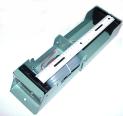 The more I fiddled around with the MG, the more features I found, and the more I liked the unit. It has one of those form follows function designs that has you poking around to discover the intent of every piece and assembly – nicely thought out.
The more I fiddled around with the MG, the more features I found, and the more I liked the unit. It has one of those form follows function designs that has you poking around to discover the intent of every piece and assembly – nicely thought out.
The way the case folds out is a perfect example. Opened, the sensors are exactly 12 inches apart which sets the timing distance. The manual cautions that the case must be full opened or the timing distance will be incorrect, so Chrony thoughtfully placed hinge stops to set the proper distance.
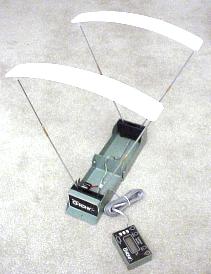 The box flops open, a 9v battery is installed which powers the chronograph and monitor. The diffusers, needed only in very bright sunlight, are a nice construction touch. The support rods each come in two short pieces, the plastic diffusers are each formed from three pop together plastic parts, each about 4.5″ long. When assembled, the shoot through area is 14.5″ high and 14.5″ wide at the top of the screen. The diffusers are used to create a uniform background to help the photocells pick up the contrast of the passing bullet. The chronograph height is adjusted so the bullet passes from 4″ – 6″ over the sensors. High power rifle muzzles should be 10′ away, 5′ for rimfire.
The box flops open, a 9v battery is installed which powers the chronograph and monitor. The diffusers, needed only in very bright sunlight, are a nice construction touch. The support rods each come in two short pieces, the plastic diffusers are each formed from three pop together plastic parts, each about 4.5″ long. When assembled, the shoot through area is 14.5″ high and 14.5″ wide at the top of the screen. The diffusers are used to create a uniform background to help the photocells pick up the contrast of the passing bullet. The chronograph height is adjusted so the bullet passes from 4″ – 6″ over the sensors. High power rifle muzzles should be 10′ away, 5′ for rimfire.
On less than extremely bright days, the diffusers are not required and simple wood dowels can replace the metal support rods. The “V” form is needed to identify the area over the active range of the photocells. The benefit of using wood substitutes is that they will shear off if shot through, rather than damage the photocell housings that secure them as the metal rods might under some circumstances. A nice improvement would be for Chrony to ship the unit with plastic rods that would be more durable than wood, but still shear off if shot. Unlike most other chronographs, the wire connecting the sensors to the monitor is standard phone cable, not coaxial cable which tends to break down over time and separate at the connectors. Nice touch.
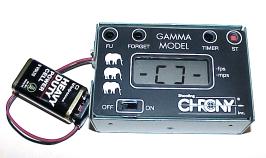 This is good. This is the monitor and remote control module for the chronograph and all of it’s functions. In use with the sensors at the range, the phone cord from the sensor box to the monitor also provides operating power. When you’ve collected your data, you can commit it to the units memory by pressing the “ST” button.
This is good. This is the monitor and remote control module for the chronograph and all of it’s functions. In use with the sensors at the range, the phone cord from the sensor box to the monitor also provides operating power. When you’ve collected your data, you can commit it to the units memory by pressing the “ST” button.
When you get home, and you’re sitting at your bench or desk, you can leave the sensor box on the shelf, plug a battery into the same phone jack on the side of the monitor, and replay all of the data, or use an interface cable to dump the data to the PC.
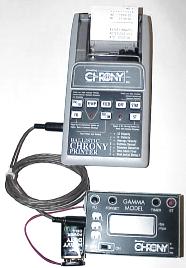 Very handy. In addition to reading and downloading, you can also analyze, statistically summarize and get a hard copy report from the included Ballistic printer. The printer plugs into another jack on the side of the monitor just below the power jack.
Very handy. In addition to reading and downloading, you can also analyze, statistically summarize and get a hard copy report from the included Ballistic printer. The printer plugs into another jack on the side of the monitor just below the power jack.
The printer is obviously made specifically for the Chrony; it has keys dedicated to only chronograph functions. The printer can be powered by batteries for range use, or with a standard AC power adaptor for prolonged use at home or at the office.
Compared to other manufacturers products, the bench bound equipment has a very small collective foot print and won’t get in the way when you’re shooting. Back at home base, the sensor unit folds up with the monitor and cables inside and, together with the printer can be tucked away is a drawer.
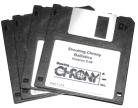 I have to admit, when I got to the PC software I thought it was a throwaway. I can’t remember the last time I saw software distributed on multiple floppy disks as opposed to a CD. The program was written in Visual Basic and the install program was really antiquated. Of course I could just be a techo snob.
I have to admit, when I got to the PC software I thought it was a throwaway. I can’t remember the last time I saw software distributed on multiple floppy disks as opposed to a CD. The program was written in Visual Basic and the install program was really antiquated. Of course I could just be a techo snob.
The program installed in Windows 98, 2000 and ME without a hitch, and started up an ran like any well written program should. Next I jumped all over the program because it cut off it’s smokeless powder data base at RL22, rather than the more recent RL25, and there were missing drawings in the program’s database for the .338-378, even though it was listed. Given a few more minutes to explore, I found a well structured personal database for handload and firearm tracking, with a whole suite of internal and external ballistics calculators and a spot to download and save data from the Chrony. In addition, all of the obsolete and missing entries were under user control and could be updated at any time. Like I said, nicely done.
Summary
At this point, I’m impressed with Shooting Chrony products. This is a well thought out, and well designed and well executed product. Whoever, or whatever group is responsible for all of this…stuff, knows firearms and ballistics, how to build test equipment and understands the need for intuitive operations, a.k.a. made for people who refuse to read manuals.
I think there is a real value here and a convenient package. I’m looking forward to evaluating the rest of the Master Gamma’s functions when I get to the range testing portion of the .257″ bore series.
Thanks
Joe

Email Notification